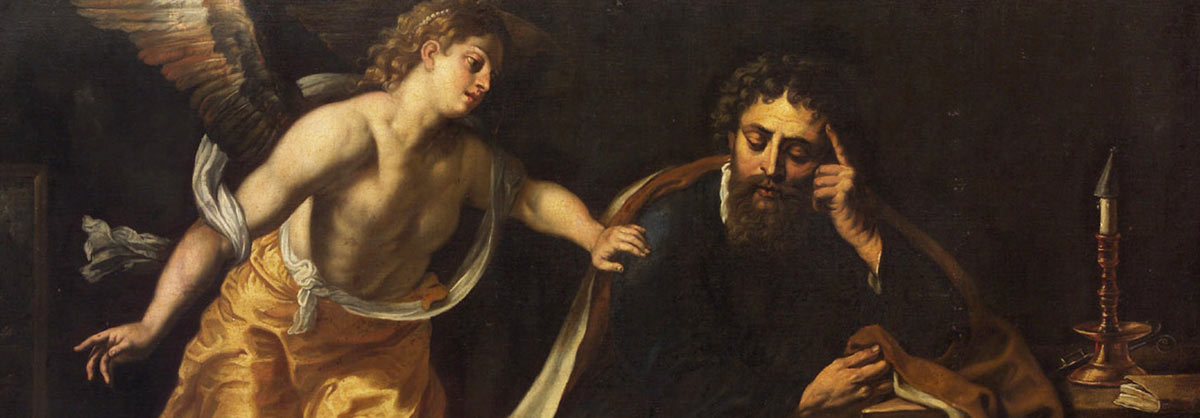
God Is With Us | Week Four
An Advent Journey with St. Elizabeth Ann Seton | A Five-Part Series
“Behold, you will conceive in your womb and bear a son, and you shall name him Jesus. He will be great and will be called Son of the Most High, and the Lord God will give him the throne of David his father, and he will rule over the house of Jacob forever, and of his kingdom there will be no end” (Luke 1:31-33).
For hundreds of years, that prophecy of Isaiah’s—of God coming to be with his people—comforted the hearts of the Jewish people. Through exile and oppression, they clung to Isaiah’s words.
Then, an angel repeated those words to Saint Joseph, not as a promise of what was to come, but as a statement of what was: Mary, Joseph’s betrothed, carried that child in her womb. God already was with his people. They just didn’t know it.
The angel’s words were a harbinger of the joy that would come, as more and more people did know. That joy came first to the Blessed Mother, then to Joseph, and after that slowly spread, from the shepherds to Anna and Simeon and eventually to everyone who encountered Jesus and recognized him for who he was.
Despite confusion persecution, sorrow, and loss, all who encountered Jesus and believed also encountered joy. They experienced the peace and enduring comfort of “God with us.”
This is why, even as we reflect on darkness, repentance, and the long waiting of the world for its savior, Advent always remains shot through with joy. It is leading us to an encounter with Jesus, who is both our joy and the one from whom every experience of joy flows.
This isn’t just true of Advent, though. Every encounter with Jesus is an encounter with joy. And so, when we remain close to him, joy can flourish, even in the midst of great suffering.
Saint Elizabeth Ann Seton’s life was in many ways, like one long Advent. The darkness of grief and loss covered it from first to last. Sorrow for her failings and shortcomings marked her adult life. And through it all, she lived in a perpetual state of waiting—for marriage and babies, healing and security, peace in her community and rest from the world. But alongside the darkness, repentance, and waiting, stood joy.
While Elizabeth was heavy with her fifth child and watching her husband’s business fail, she experienced a profound religious awakening—what she called, “the birthday of her soul.” “Never would I have thought of such enjoyment in this world,” she wrote, describing her encounter with God. “Last night was surely a foretaste of the next.”
Later, as she faced poverty, estrangement from family and friends, and the loss of her place in society, she wrote of the ecstasy she experienced when receiving Holy Communion for the first time. “At last, GOD IS MINE AND I AM HIS.”
Mother Seton still suffered. She felt sorrow. But in the midst of that sorrow, joy perdured. Not because of the life that was, but rather because of the life she hoped for: eternal life with Jesus. Writing not long before her death, after losing yet another treasured sister, she spoke of how she “felt happy, contented, embracing my lot with…joy.”
But, she added, that was because “I have not the power to wish or care for anything but heaven and eternity.”
As Advent draws to a close, look for that joy—the joy of the babe in the manger. No matter what grief walks with you through the Christmas season, keep your eyes fixed on him, knowing that God is not just with us, but with you. And rejoice.
Questions for Reflection
- Would you describe yourself as joyful? Why or why not?
- Have you ever experienced joy alongside suffering? What made that possible?
- What is one thing you can do to keep an encounter with Christ, the source of every joy, at the heart of your Christmas celebrations?
INTRODUCTION | An Advent Journey with St. Elizabeth Ann Seton
WEEK ONE | Hope in the Darkness
WEEK TWO | To Trust God and Repent
WEEK THREE | Waiting for the Lord
WEEK FOUR | God Is With Us
Emily Stimpson Chapman is an award-winning writer on ‘all things Catholic’—from politics and catechesis to higher education and the media, with a special focus on the Church’s teachings on marriage, sexuality, and femininity. She is the author of many books including Letters to Myself from the End of the World (Emmaus Road, 2021), Hope to Die: The Christian Meaning of the Resurrection of the Body (co-authored with Scott Hahn, 2020, Emmaus Road), and The Catholic Table: Finding Joy Where Food & Faith Meet (Emmaus Road, 2016). She recently released two children’s books, Mary:Mother of All, and the Supper of the Lamb, both co-authored with Scott Hahn. Honored by the Catholic Press Association and the Associated Church Press, you can read Emily’s latest at her Substack newsletter Through a Glass Darkly, and on Instagram (@emilystimpsonchapman). Links to all her content can be found at her linktree page. She lives in Pittsburgh with her husband and three young children, ages 4, 2, and 1.
Image: Dream of St. Joseph, Gerard Seghers, 1591-1651